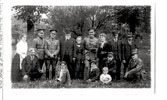A fruitful legacy - Glimpses of the Past with Karen Webster
If we could travel back in time 100 years or more, and head to the first farm north of Blyth on the east side of London Road (Lot 2 Conc. 9 Morris Township), we would find a prosperous property called Maple Farm. It was here that the family of Andrew Williamson Sloan lived.
Andrew was the son of a doctor, Thomas Sloan, a native of Dumfriesshire, Scotland. The Sloan family lived in the Oshawa area, then near St. Marys, before settling in Hullett Township. In 1865, Andrew wed Janet McMichael in York and to this union were born Thomas (1866), John (1868), William (1869), Mary (1871), Margaret (1876), Robert (1881) and Andrew (1885).
In 1875, 12 years after the land had been purchased by Hugh McKeller from The Crown, Andrew and his young family moved from Hullett Township and took up residence on the northern outskirts of Blyth. It was here that he built up a prosperous and progressive farm. Most early farms in Huron County possessed an orchard, both to provide food for the family and to generate extra income. Apples were a commodity that could be packed in barrels and exported to Europe. When Andrew started his orchard, Joseph Coombs, Andrew’s son-in-law, helped with the planting
Andrew, also known as A.W., took his orchard to another level. At one time, his son, Robert, who later ran a successful orchard in Goderich Township, recalled that his father grew Spy, Baldwin, Rhode Island Greening, King of Tomkins, Ben Davis, Twenty-one-Ounce Pippin, Seek-no-Further, Ribston Pippins, Russet Goldens, Russet Roxboros, Wagner, Gravenstein, Mammoth Pippins, Talman Sweet, Maiden Blush, Snow and Ontario apples. The apples produced on Maple Farm were of a quality that Andrew, as part of the Huron Apple Growers Association, entered five of his apple varieties in the Ontario Horticultural Exposition in Toronto.
In 1892, in a newspaper item telling of 23,000 barrels of apples shipped from the Blyth train station, it was reported that Andrew Sloan, from one acre of his property, had sold $240 worth of winter apples, in addition to the sale of harvest and fall apples from that same acre. The apple trees were cropped until about 14 years old. Each year, new trees would be planted to ensure the continuation of the orchard.
At the orchard’s prime, several workers would be employed in the business of operating it, doing pruning, spraying, picking and packing of the apples. Hence, a large bell was installed in the yard of Maple Farm and was used to summon the workers to their meals. This bell passed down through the hands of various family members, in several locations in Ontario, until 2013, when A.W.’s granddaughter donated it to the Huron Pioneer Threshers and Hobby Association. She remembers, as a youngster, being allowed to ring the bell, but only one time. This artifact, inscribed with the words ‘Poppy’s Bell” is brought out of storage each September during the reunion to reside near the cabin where new generations of youngsters have the opportunity to ring it.
Following Andrew’s death in 1917, Andrew Jr. was the owner and he continued the family business until 1927 when the property was sold to Fredrick Oster. In 1934, a severe winter with exceptionally low temperatures decimated many of the local orchards when the bark on the trees split. Most of Andrew Sloan’s orchard was destroyed, including the only trees bearing Sloan Spy, a variety that Andrew had developed.
Andrew’s proficiency extended beyond his apple expertise. He was elected as the president of the local horse fairs in 1907. Because his property included part of the Village of Blyth, he was eligible to serve on the local council, rising to the position of Reeve for several years in the early 1900s. In politics, he was a Liberal. As well, he was a member of the first board of trustees for USS #3 Morris and East Wawanosh School when it opened in 1881. A person who was civic-minded, Andrew Sloan served on the building committee of the second Blyth Presbyterian Church in 1877, and by 1912, A. W. Sloan was on the board of the Blyth Telephone System.
In 1876, The New Era newspaper reported that Mr. P. Straith had removed the boiler, vats and other appliances from the former Clinton cheese factory to set up a new 100-foot-long factory on the corner of Andrew Sloan’s farm. The signing officers for this enterprise were J. Richmond, George McGowan, Mr. Dunbar, auditor, and Andrew Sloan. This co-operative continued for several years, serving the local dairy farmers.
Eight acres of the Sloan farm were part of the village of Blyth and it was here that Andrew’s brother, Dr. William Sloan lived in a large white brick house.
When Andrew was visiting his daughter, Margaret Walker, in Goderich in March of 1917, he passed away, the cause of death recorded as “La Grippe” another name for influenza. He was survived by his wife, Janet, and children: Thomas, Hullett Township; John of Alaska; Dr. William, serving in the 1st Battalion in France; Mary Coombs, Toronto; Margaret Walker, Goderich; Captain Robert, 33rd Overseas Battalion, and Andrew, living on the home place.
Andrew Sloan, after living a full and fruitful life, was buried in Blyth Union Cemetery.


